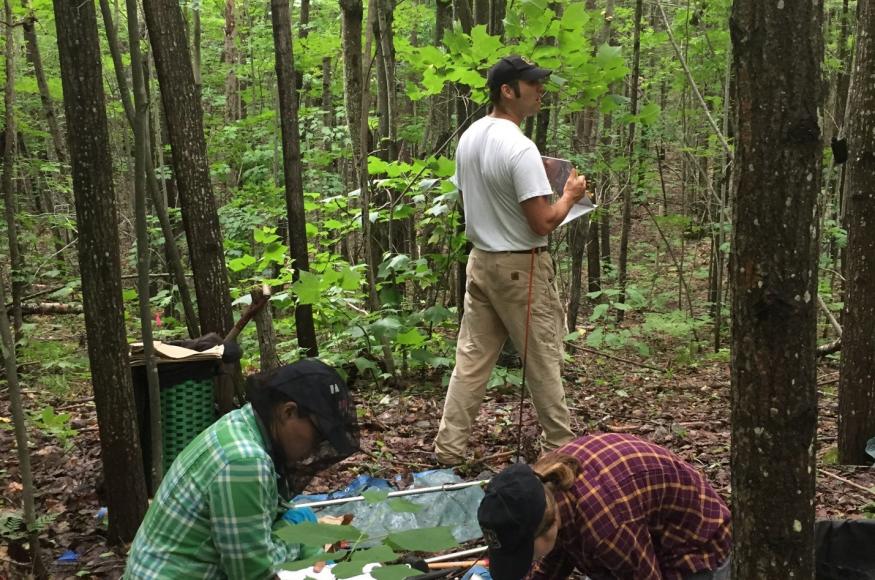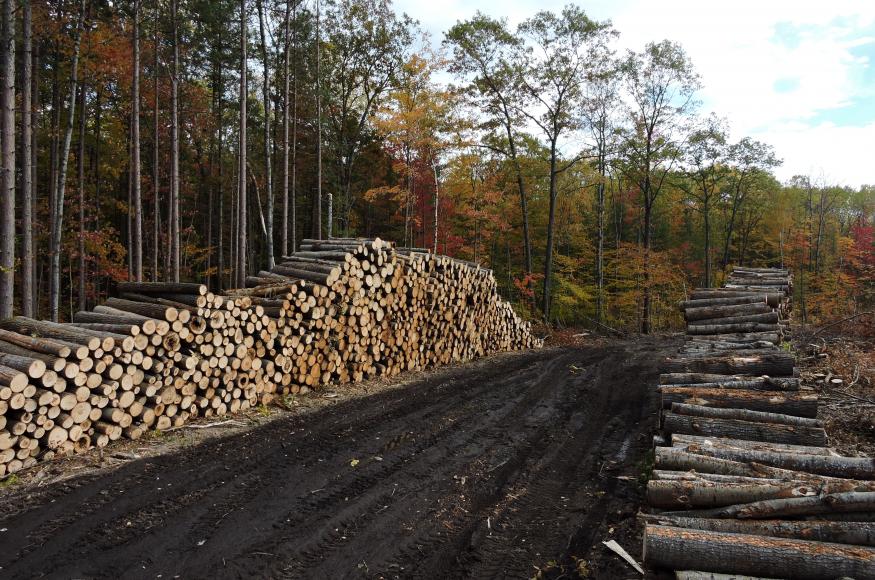Project Area
 The Adaptive Aspen Management Experiment is a 465 acre landscape of moraine, outwash plain, and postglacial lacustrine and dune landforms. It has complex topography, soils, hydrology, and microclimates, but forest compositional and age class diversity are rather low. Aspen (mostly bigtooth) established after post-logging fires between 1900 and 1920 dominates the forest cover over about 90% of the area; the remainder is small (6-10 acre) aspen-dominated stands established after harvests in the 1970s and 1980s. On the mesic, nutrient-rich soils of the moraine, aspen growth rates and standing biomass are among the highest in the Lake States. In these areas, accessory species are northern hardwoods, with localized forested wetlands of trembling aspen, balsam poplar, balsam fir, northern white cedar, and ash. On the drier outwash, lacustrine, and dune landforms, sandy soils have favored white, red, and scattered jack pines as accessory species intermixed with the aspens.
The Adaptive Aspen Management Experiment is a 465 acre landscape of moraine, outwash plain, and postglacial lacustrine and dune landforms. It has complex topography, soils, hydrology, and microclimates, but forest compositional and age class diversity are rather low. Aspen (mostly bigtooth) established after post-logging fires between 1900 and 1920 dominates the forest cover over about 90% of the area; the remainder is small (6-10 acre) aspen-dominated stands established after harvests in the 1970s and 1980s. On the mesic, nutrient-rich soils of the moraine, aspen growth rates and standing biomass are among the highest in the Lake States. In these areas, accessory species are northern hardwoods, with localized forested wetlands of trembling aspen, balsam poplar, balsam fir, northern white cedar, and ash. On the drier outwash, lacustrine, and dune landforms, sandy soils have favored white, red, and scattered jack pines as accessory species intermixed with the aspens.
Management Goals

The wider goals of forest management at UMBS are to make its forestland less vulnerable to climate change, support research and teaching, and build relationships between UMBS, forest-climate science and outreach organizations, and the forestry industry. Specific goals and objectives for the Adaptive Aspen Management Experiment include:
- Increase forest age class, structural and compositional diversity: remove the dominant, mature aspens (and select other trees) from 4 management units to increase physical and biological heterogeneity.
- Test resistance, resilience, and transition concepts in the context of aspen-birch management: implement treatments that demonstrate how these broad climate adaptation concepts are achieved through unit-level actions.
- “Work with the site” to enhance the probability that management will increase forest adaptive capacity: design treatments and prescribe tactics to take advantage of variation in topography, soils, hydrology, and species composition between and within the management units.
- Demonstrate and communicate the ecosystem consequences of forest management: study, report, and publish the impacts of management options (including no management) on forest composition, carbon storage, soil biogeochemistry, and hydrology.
Climate Change Impacts
For this project, the most important anticipated climate change impacts are:
Increased frequency of intense precipitation will increase the frequency of saturated soils, making stands more susceptible to windthrow. Ice and wet snow storms may increase tree damage, especially in dense young or old diseased aspen.
Drier soils and warmer temperatures will increase tree water deficits, stressing or killing individuals of moisture demanding species or species facing compounding stressors (e.g., fungi or insects), or both (e.g., beech, ash, paper birch, aspen).
Thinner, shorter-duration snowpack will increase the frequency, duration, and extent of frozen ground in the near term, potentially increasing root mortality and tree susceptibility to pathogens, windthrow, and growing-season drought.
Challenges and Opportunities
Climate change will present challenges and opportunities for accomplishing the management objectives of this project, including:
Challenges
Shorter, thinner winter snowpack, and warmer temperatures that inhibit the freezing of trails and roads may limit site accessibility for harvesting during the preferred winter months
Regeneration and recruitment of desired understory species may be hindered by shorter, thinner snowpack and the resulting increase in deer browsing pressure
Even a single intense precipitation and/or wind event can damage a significant proportion of merchantable timber volume
Accelerated decline of tree species affected by pathogens may result in greater losses of potentially merchantable timber volume to death and decay
Opportunities
Longer growing seasons may increase the already very high site productivity, allowing for more rapid regrowth after disturbances or more frequent harvesting
High forest connectivity, the proximity of temperate tree species a short distance to the south (e.g., white and northern pin oaks), and appreciable stocking of “climate-change winner” tree species at the site may provide a wide suite of potential options
Better-than-expected growth of select species, survival of disease-resistant individuals (e.g., beech, ash), or positive site-dependent responses (e.g., white pine or birch responding well on specific ecosystem types) could reveal other options
Adaptation Actions
Project participants used the Adaptation Workbook to develop several adaptation actions for this project, including:
Area/Topic
Approach
Tactics
Overall Aspen-birch area
Increase spatial heterogeneity in stem distribution and canopy layering at sub-unit, unit, and whole project area levels
Increase the area of younger-age patches, and add an entire age class, by conducting harvesting in management units now and potentially again in 5-20 years
Resistance unit
4.1. Prioritize and maintain unique sites.
4.2. Prioritize and maintain sensitive or at-risk species or communities.
4.2. Prioritize and maintain sensitive or at-risk species or communities.
Focus resistance treatment in Unit 13, where soil & topography are most likely to promote persistence of cool moist conditions. Regenerate boreal species including paper birch and three aspen species through canopy removal and ground scarification.
Resilience units
2.3. Manage herbivory to promote regeneration of desired species.
5.2. Maintain and restore diversity of native species.
5.2. Maintain and restore diversity of native species.
In Unit 3, create large residue piles to inhibit deer access to desired regenerating species. In Units 3 and 9, remove 75% and 95% of aspen (respectively), in order to regenerate aspen while releasing scattered codominant individuals of other species
Transition unit
9.2. Establish or encourage new mixes of native species.
9.3. Guide changes in species composition at early stages of stand development.
9.3. Guide changes in species composition at early stages of stand development.
In Unit 7, carefully remove aspen, retaining diverse co-dominant and understory species and maintaining canopy closure. Inhibit aspen regeneration through shading, move succession towards long-lived species.
Monitoring
Baseline monitoring was ongoing for several years prior to harvesting treatments. The ongoing monitoring program includes planned and optional items:
Quantify microclimate, soil moisture and groundwater levels in managed units, intermediate-aged, and reference stands
Quantify soil and groundwater C fluxes to test for management and disturbance impacts
Inventory physical damage in all management units following future severe weather events such as convective squall line winds and ice storms to assess whether structural manipulations decreased disturbance impacts
Monitor establishment, growth and recruitment of desired future species in all management units, with special attention to browse inhibition treatments (e.g., slash piling), to assess browse impacts on understory species
Composition and aboveground biomass of managed vs. reference stands
Optional: Leaf water and C isotope sampling to determine whether rooting depth and water sources change in response to management
Optional: Stem patchiness and canopy structural complexity in managed vs. reference stands, assessed with LiDAR
Project Documents
UMBS Aspen Managment Overview_v7.pdf
(301.75 KB)
Keywords
Carbon mitigation
Early-successional habitat
Research
Upland hardwoods








